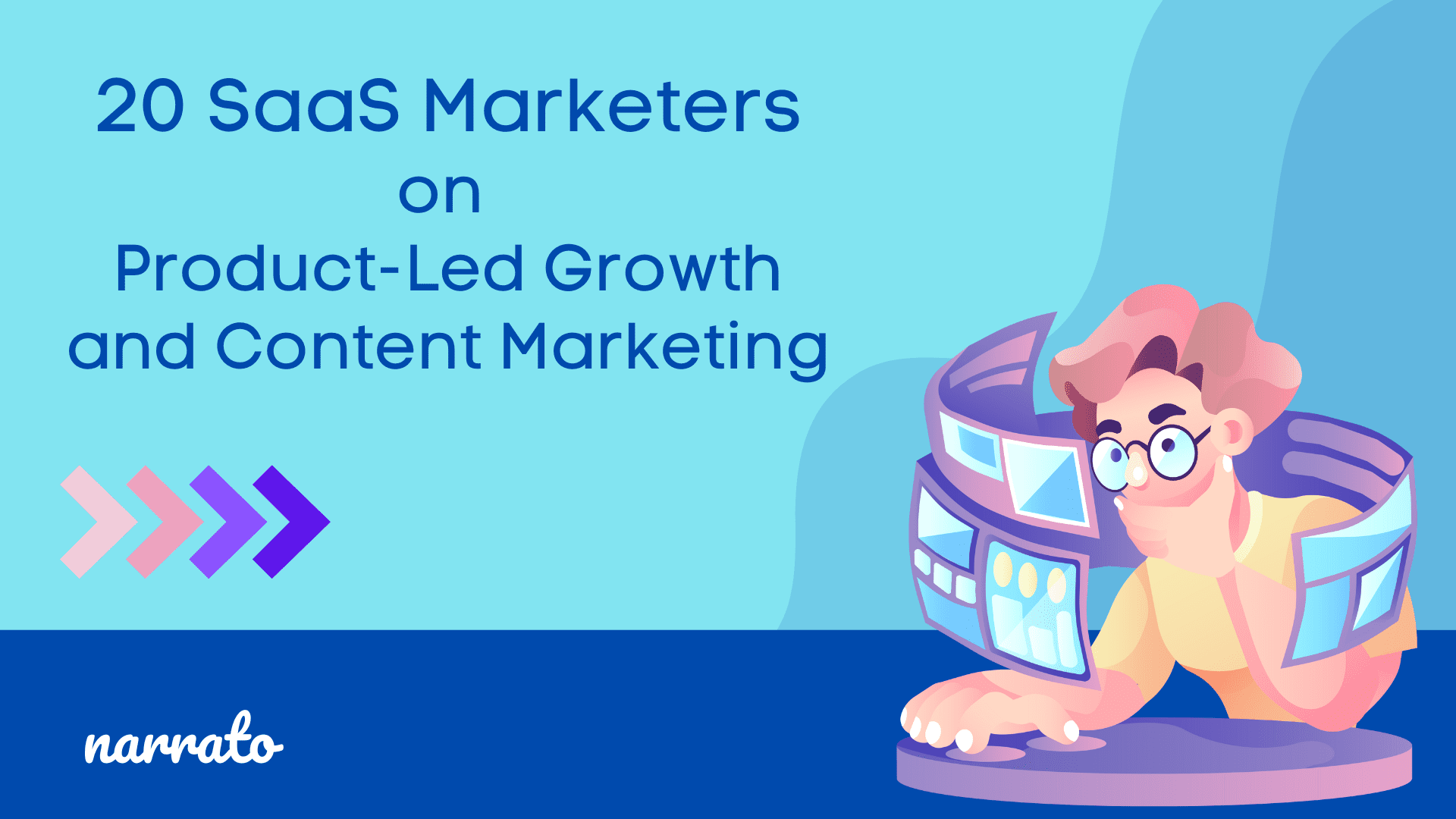Many content marketers try to avoid mentioning their SaaS products explicitly in their content to avoid the risk of sounding too self-promotional. Up until a few years ago, SaaS content marketing was all about “being the television show and not the ad”. The focus was primarily on creating content that the audience would find interesting and useful.
Product-led content marketing has turned this approach on its head. Product-led content is at the center of most popular SaaS companies’ content strategies. Be it the ClickUp content marketing strategy or HubSpot’s content strategy, product-led marketing is the secret to better customer acquisition.
In our recent interview, we asked 20 experts about their thoughts on product-led content, PLG strategy, and content marketing in general. We specifically asked them the following questions –
1. How do you use content to drive growth for your SaaS business?
2. What kinds of content do you create and how do you plan your content calendar?
3. How important is SEO for content creation and how do you approach it?
4. Does product-led content marketing work? What results have you seen through this strategy?
Here is what they had to say –
TL;DR here’s a quick summary video of this article.
- Content is the main driver of product-led growth for SaaS companies. Product-led SaaS marketers have seen an increase in conversions
- Content needs to be short-form, engaging, and tell a simple story that focuses on the key benefits of the solution you provide
- Blogs are the most popular type of SaaS marketing content that nearly 100% of marketers invest in. Other long-form content like case studies and e-books are preferred formats too
- Most SaaS marketers believe videos can be great for product-led storytelling as it increases your scope beyond just written words and still images. Videos allow you to show your SaaS product in action
- Creating compelling content that answers audience questions is a key to winning with SEO as well. Search engines reward helpful content
- Social media channels have become discovery platforms for SaaS users, each one with its own search engine, where SEO criteria apply as well
- Almost all SaaS marketers have a monthly content calendar where all the content is planned at least one month in advance
- Product-led content is not just about growth in revenue but also growth in awareness, followers, users, and requests to collaborate
- With product-led content, you can give readers a non-sales-oriented walkthrough of how to use your product and its unique features
- Product-led content helps simplify complex SaaS products (with so many features and capabilities) for the audience, which could have otherwise been overwhelming for a user to discover on their own.
- SaaS buyers, particularly B2B buyers, take their time to arrive at a purchase decision, Providing them with valuable product-led content meanwhile can be a great lead nurturing tactic

Product-Led Growth for SaaS Companies – The Interviews
1. John Rarrick, Head of Marketing, Movius

Q. How do you use content to drive growth for your SaaS business?
A. Unlike consumer products, SaaS stories can be difficult to tell. There are often complicated, multi-phased use cases that, if not described with brevity, can lead to confusion with less technically-savvy customers. Content needs to be short-form, engaging, and tell a simple story that focuses on the key benefits of the solution you provide.
Q. What kinds of content do you create and how do you plan your content calendar?
A. If we are trying to reach the top of the funnel (Brand/Product Awareness), we will almost always go with video content. Video tells a story better than any other content form and allows us to begin the conversation more effectively. Since we service several Enterprise verticals, we typically post content every day or every other day.
We’re also big fans of long-form audio content (podcasting) as it really helps us to tailor the content to our very specific audiences.
Q. How important is SEO for content creation and how do you approach it?
A. SEO and content go hand-in-hand. But we always begin with the intention of creating compelling content first, and then address its impact on SEO second.
Q. Does product-led content marketing work? What results have you seen through this strategy?
A. We’ve seen 4X growth in lead generation since shifting to product-led marketing. So, I’d say it’s working.
2. Jonah Wilson, BDE, Convirza

Q. How do you use content to drive growth for your SaaS business?
A. We make –
- Consistent Blogs
- Downloadables
- Podcasts
- Videos
- TikTok videos (and using high-performing short form content on other platforms)
- Webinars & Events
We aim to give our ideal customer value, so they know we are a leader in the space and have answers to problems they may face.
Q. What kinds of content do you create and how do you plan your content calendar?
A. We create informational content for our target market, primarily marketing agencies and large enterprises.
Examples include –
- How to use google analytics
- Influencer marketing statistics
- How to increase web traffic
We plan our content calendar using Google Sheets. 30 days out for social media posts (Facebook, LinkedIn), weekly for TikTok / other short-form content, 2-3 months out for long-form content.
Q. How important is SEO for content creation and how do you approach it?
A. Incredibly important. We use plug-ins to optimize and run pages through AI content SEO assistants to optimize. We follow Google Trends, trending topics on social media, and other content creators to see what is most effective.
We approach it by first finding what keywords provide the most value, next testing platforms to see what people respond to, then making the pages accordingly. We then monitor traffic and rankings.
Q. Does product-led content marketing work? What results have you seen through this strategy?
A. We have spent thousands of dollars on product-led marketing. We find in general, the audience reacts coldly to it. This leads us to a more nurture approach with the majority of our marketing efforts, where we simply provide valuable information to our target audience.
Results: 20% increase in revenue so far in 2022. Website Traffic consistently grows 5-10% monthly.
3. Chris LaFerla, Founder, Tatem

Q. What kinds of content do you create and how do you plan your content calendar?
A. We post a weekly changelog, a monthly blog post (which is very SEO focused), and a weekly summary of all learning that we had as a business. We share these across our website, LinkedIn, and Twitter.
This has led to growing the number of followers we have on all platforms by several hundred (from 0) since starting the business a couple of months ago. Our goal on the content is really to just gain exposure.
Q. How important is SEO for content creation and how do you approach it?
A. We’re very focused on gaining backlinks, and we are also focused on having our blog posts be drivers of SEO in the future. That way, we can build a predictable path towards ranking for certain (easier-ranking) keywords which will drive recurring organic traffic.
Q. Does product-led content marketing work? What results have you seen through this strategy?
A. Thus far, we have received well over 100 users (which is not insignificant for a new business) coming directly from organic sources.
However, where it definitely works is gaining exposure and broadening the reach of your business. It may not result in instant customers, but it does (over time) make a big impact.
4. Melissa Kwan, CEO, eWebinar

Q. How do you use content to drive growth for your SaaS business?
A. In this day and age where consumers prefer to self-serve some or all of their buying journey, content marketing, and SEO are one of the few things that work for driving growth (through traffic) for our SaaS business.
We create co-marketing content with our partners (could be promotional partners or tech integration partners) that become educational evergreen content we can both promote and lives on the internet forever. And we’re constantly creating SEO-optimized pieces of content for keywords we want to rank for, about 2 long-form pieces every month. You can no longer dictate when and how prospects find you, you can only be there when they come looking, and make sure they can have access to the info they need to make a decision on their own.
Q. What kinds of content do you create and how do you plan your content calendar?
A. Here’s what we do with our content –
- We create long-form researched SEO pieces that are optimized for keywords that we want to rank for.
- We record videos that are delivered through eWebinar as evergreen webinars that offer educational value to our prospects and customers.
- Then we write companion articles that summarize the webinar to put it on our blog so people can find the webinar beyond the first email and social blast.
- We interview customers and create featured stories that live on our site, and that helps convert prospects who are doing research on our site, who might be on the fence.
- Any time a happy customer comes through, we ask them to write a review on Capterra to publicize their positive experience.
Q. How important is SEO for content creation and how do you approach it?
A. For a $50 starting point subscription, SEO is everything because 1-on-1 outreach doesn’t work, and it’s expensive and inefficient. The way we approach it is as best as we can, one step at a time. It’s extremely hard to measure, but since we’ve started focusing on SEO and content, our demos per month have been increasing by 10% every month.
There’s so much you need to do but as a bootstrapped company with so little resources and no one that specializes in marketing, we’re learning from our peers, researching best practices on the internet, and trying things out for ourselves.
Digital marketing is the new sales, and companies like us need to get on board with that, otherwise, we’ll get left behind. I’ve been in enterprise sales for almost 20 years, and I’ve never had such a hard time getting people to respond as in the last 2 years.
Q. Does product-led content marketing work? What results have you seen through this strategy?
A. For a product at our price point, it’s the only thing that works because nobody wants to pick up the phone for $50.
5. David Bitton, Co-Founder and CMO, DoorLoop

Q. How do you use content to drive growth for your SaaS business?
A. When done correctly, content marketing does wonders for brand exposure and association. Making engaging material that grabs readers’ attention is essential to effective content marketing. Creating conversationally written, personality-driven content is the most effective approach to do this. The engagement and loyalty of your target audience will grow when you produce content that speaks to their personality.
Q. What kinds of content do you create and how do you plan your content calendar?
A. Our primary focus is on blog entries. Blogging is simple, versatile, and easy to use, making it very successful in gaining organic reach. Since blog content can readily be reused for social media, it also aids in maintaining our online presence. Our blog acts as our content repository, allowing us to publish content on social media promptly.
Q. How important is SEO for content creation and how do you approach it?
A. Content is essential for SEO. To give our content SEO value, we create helpful and engaging content relevant to our target audience. To be considered authoritative by SERPs and receive high search engine rankings, your content must provide users with valuable information.
Q. Does product-led content marketing work? What results have you seen through this strategy?
A. Integrating your product within your content is effective because you can demonstrate how to use it to your audience. One of the most challenging tasks for most SaaS businesses is teaching customers how to use a product, especially if it has many features. With product-led content, you can give readers a non-sales-oriented walkthrough of how to use your product and its unique features.
6. Adam Gingery, COO, Majux

Q. How do you use content to drive growth for your SaaS business?
A. We helped Sootchy, a FinTech startup, by growing their organic search traffic 282% year over year with content.
- First, you’ll need to identify your core audience and compile a list (the bigger the better) of questions and concerns they might be having. Using keyword research tools, peruse Reddit, spend a few hours digging through Quora, or talk to folks in the industry to populate your list of questions.
- Then, you start writing. Publish posts on your website, use those as scripts for videos, then use Facebook pixels and Google Analytics to create retargeting audiences. You can create a whole marketing funnel with content being right at the top.
Q. What kinds of content do you create and how do you plan your content calendar?
A. I hinted at this already, but each piece of content should directly answer a particular concern or question that your target audience has. With Sootchy, for instance, we targeted questions like, “Can 529 Plans Be Used For Law School?” When people Google these questions, they may find your website and enter your funnel, so to speak.
You can then repurpose this content for things like: Youtube videos, Facebook/IG posts, TikToks, Twitter threads, LinkedIn lead capture campaigns, email campaigns, and more.
Q. How important is SEO for content creation and how do you approach it?
A. If you’re in the process of building an audience, SEO is everything. You need to select topics based on keyword research, you need to intelligently outline your blog posts, you need to include internal links from one post to the other, and you need to optimize your page titles and meta descriptions.
If you already have a huge audience and your primary goal is engagement, you might take a different approach. For instance, if you’re thinking of content that will convince your 10,000-subscriber email list to buy a new product, SEO doesn’t need to be a factor.
Q. Does product-led content marketing work? What results have you seen through this strategy?
A. If your product solves a pain point in a specific niche, this strategy is incredibly important. I’ve written for CallRail’s blog and partnered with them on webinars, and that’s their whole strategy. They sell phone call tracking software as a service for law firms, and most of their content involves marketing and data attribution. This strategy has skyrocketed their company.

7. Linda Shaffer, CPOO, Checkr

Q. How do you use content to drive growth for your SaaS business?
A. Content is the main driver of product-led growth for SaaS companies, including ours. It is the best way to communicate with and engage your target audience, and it is also the best way to promote your product or service.
We use content to inform our target audience and current users about the benefits of our product, as well as to promote our brand. Not only that, but we also provide valuable and relevant content within our niche to establish ourselves as experts. This, in turn, drives more organic traffic to our website and product pages.
For example, in the Checkr blog, we tackle topics like remote work, DEI practices, winning culture, fair chance hiring, and more, other than background checks.
Q. What kinds of content do you create and how do you plan your content calendar?
A. We mostly create blog posts. We have a team of in-house writers who produce original content, and we also work with guest contributors and industry experts. However, our leadership also regularly appears as guests in podcasts and gets interviewed by other media outlets.
As for our content calendar, we plan and publish our blog posts two weeks in advance. We also make sure to promote our content across social media channels and through email marketing. In addition, we repurpose our content into different formats to make sure that we’re maximizing its reach.
Q. How important is SEO for content creation and how do you approach it?
A. SEO is very important for content creation, especially for SaaS companies. It helps our target audience find our content more easily and also boosts our website’s ranking on search engine results pages.
When creating content, we always keep SEO in mind. We make sure to use the right keywords and phrases, as well as to optimize our titles, meta descriptions, and images. We also create backlinks to our website to further improve our ranking.
Q. Does product-led content marketing work? What results have you seen through this strategy?
A. Absolutely! We’ve seen great results from our product/service-led content marketing strategy. Thanks to our informative and engaging content, we’ve been able to attract more organic traffic to our website and product pages. In addition, we’ve seen an increase in conversions and sales. This just goes to show that product/service-led content marketing is an effective way to drive growth for SaaS businesses.
8. Bill Harrison, CEO, Compliance Bridge

Q. How do you use content to drive growth for your SaaS business?
A. We primarily drive growth through content in two ways –
- First, we use content for organic lead generation. If our content is useful, correctly uses strong keywords, and overall, has value to the reader, it helps us move up in the search results, allowing more people to find our site.
- Then, we use our content for lead nurturing. By sharing articles in a monthly newsletter, sending out sales emails, etc., we’re able to keep the conversation going with potential customers.
Q. What kinds of content do you create and how do you plan your content calendar?
A. Most of our content comes in the form of blogs. Each blog is assigned a relevant keyword, has a short summary of the content, and includes a few resources for the writers to gather information from. In addition, we post press releases anytime we make major changes to our software. This content isn’t optimized for SEO, but it does help relay vital information to our current customers. And finally, we also create case studies and ebooks. The goal of this content is to position ourselves as thought leaders in the industry, which helps us gain the trust of prospective clients.
Every quarter, we prepare a content calendar with two blogs a month.
Q. How important is SEO for content creation and how do you approach it?
A. SEO is at the heart of most of our content. We start by researching relevant keywords. Then we narrow down the list so it only includes those with a high enough search quantity and low enough difficulty for us to rank for. After that, we build our content around the best keywords, carefully weaving one into each blog in a natural way for the reader.
Q. Does product-led content marketing work? What results have you seen through this strategy?
A. We’ve found that product-led content marketing is vital to a strong content marketing strategy. When people come to your website, for instance, they should be able to see exactly what your SaaS product does, how it can benefit them, and what specific problems it can solve.
This type of marketing isn’t necessarily aimed at getting people to our site, however. Instead, it’s more focused on guiding potential customers through the sales funnel once they’ve already reached the website.
9. Francois Gouelo, Co-Founder, Enso Connect

Q. How do you use content to drive growth for your SaaS business?
A. We use content to drive traffic to our website and generate inbound sales leads. As a startup company, we are highly relying on organic growth, investing resources into content creation and distribution. The most successful content is the one made in collaboration with partners, as it gets us in front of new audiences.
Q. What kinds of content do you create and how do you plan your content calendar?
A. We are lucky to have a great digital designer in the team, that’s why our video game is strong. We repurpose videos on different social media platforms to amplify our reach. Blog posts, articles, and case studies are another great source of traffic. We create a lot of product-led content for our email list subscribers.
We build our content plan around four main pillars: product, company culture, industry educational content, and addressing our customers’ pains (Q&A, how-tos, and guides). And there’s always room for news and other ad-hoc occasions.
Q. How important is SEO for content creation and how do you approach it?
A. SEO is very important for content discovery. We optimize both videos and copy for search when publishing on our website and on social media. Social media, especially Youtube, Instagram, and TikTok have become discovery platforms, each one with its own search engine, where SEO criteria apply. And we need to play by these rules.
Q. Does product-led content marketing work? What results have you seen through this strategy?
A. In complex SaaS products, like our platform, product-led marketing definitely works. It is the way to address the needs of our audience and show that our platform is the go-to solution to tackle these needs. The key here is to not only say that we can solve our customers’ problems, but also walk them through the process of achieving these goals. Educating and guiding rather than selling.
The hospitality technology industry is saturated with multiple fragmented solutions. Operators are overwhelmed and are looking for ways to simplify and consolidate their tech stack. They are expecting action items and comprehensive How-Tos rather than information overflow. We’ve been seeing continuous progress for the last 6 months, creating and sharing product-led content with our audiences.
10. Sanket Shah, CEO, InVideo

Q. How do you use content to drive growth for your SaaS business?
A. We consistently work on content planning, creation, and distribution, which helps us grow our SaaS business.
Q. What kinds of content do you create and how do you plan your content calendar?
A. Some of the types of content we create are SEO-focused content, product education, sales enablement materials, newsletters, and social media content.
Planning the content calendar includes reflecting on the previous month, and the promotional focus of the current month, filling out the monthly calendar, brainstorming the topics, and executing the work.
Q. How important is SEO for content creation and how do you approach it?
A. SEO is very important for content creation and we make sure to keep a healthy mixture of evergreen and timely content taking into account the keyword strategy.
Q. Does product-led content marketing work? What results have you seen through this strategy?
A. Product-led content marketing works as one of the most cost-effective methods of customer acquisition and retention for a SaaS company.
11. Danny Trichter, Co-Founder, Accessibility Checker

Q. How do you use content to drive growth for your SaaS business?
A. Content creation allows businesses to become visible. Even with SaaS products and businesses, content is what gets the word out and brings eyes to your website/product/service.
Q. What kinds of content do you create and how do you plan your content calendar?
A. One of the ways we create content is through informative blog posts that usually answer questions that people in our target audience have related to the industry that we’re in. Lead by answering the audience’s questions and, whenever relevant, introduce how your product is something they’d want to look into.
Q. How important is SEO for content creation and how do you approach it?
A. SEO is important because it determines your discoverability. The easier you are to discover, the more accessible you are to prospects. Using SEO strategies is critical but you can’t just rely on having content that’s riddled with keywords without offering much value. With the recent helpful content update from Google, we can predict bot-like content that’s containing more keywords and phrases than actual information. This kind of content will be going down the rankings.
12. Vito Vishnepolsky, Director, Martal Group

Q. How do you use content to drive growth for your SaaS business?
A. Inbound marketing for SaaS companies is about luring people in by publishing valuable content and letting them come to you instead of you actively pursuing them. SaaS marketing teams can do that by creating content that answers their questions and solves their problems. Once you have them on your site, you can gather their information and start building a relationship with them.
Q. What kinds of content do you create and how do you plan your content calendar?
A. One of the great things about inbound content marketing is that you’re not hard selling anything and are presenting yourself as an actual resource. Leads acquired that way also tend to be more valuable and often turn into long-term customers. However, creating and finding valuable content that will be targeted for your audience can be costly. And it can take more time to get results.
One of the most common mistakes done when implementing the content marketing strategy is trying to save some cost and publishing only 2-3 blogs/month, having less than 3000 words. This strategy is presenting some cost savings, but will not move the needle. The minimum length should be 5000 words and the minimum frequency of publication should be 4 blogs / month.
In our experience, SaaS companies can increase the number of leads by 25-35% in 3- 6 months, if they follow the content publishing calendar.
Q. How important is SEO for content creation and how do you approach it?
A. Very important, it is highly recommended to use AI writing and SEO assistants to check the score of every blog before publishing.

13. Anna Kirina, Global Marketing Manager, Agro Club

Q. How do you use content to drive growth for your SaaS business?
A. The first and foremost thing is to demonstrate the practical use and benefits of your SaaS tools to business owners and executives. By the content and the messages you create, you almost repeat the marketing funnel, where awareness (of your brand, product, or the industry challenge) comes first. Then followed by details to gain some real Interest, after you keep in mind someone’s consideration (to get a demo, to learn more, to compare) that your product or brand may cause. And once you manage to position it right, there’s a good chance to convert your audience (opponents, addressees, followers, or readers) into leads and satisfied customers.
But one should never forget about the “after purchase interaction”. From the content point of view, that would be the constant communication and conversation with the audience (by means of webinars, events, customer stories, etc).
Being specific, I always keep in mind the conjunction of following actions –
- Awareness (agriculture needs technology and we’re here to help)
- Interest (what are the benefits of our tools, how do they serve different purposes from an efficient grain trade via our digital platform to sales enablement software for input manufacturers and distributors)
- Consideration (for example, “why Agro.Club?” – “cause we’ve been in your shoes for years and big Ag brands trust us”)
- Convert (at times we share the numbers to show that it works)
- Conversation (we do have success stories to tell)
When choosing a SaaS products provider, a potential customer needs time to make the decision. In the Ag industry it may take months and years! But consistent and continuous work with content through different channels must never stop educating and building trust in the brand.
Once you use the power of content marketing properly, it can:
- Increase the number of touch points with your brand online
- Reach new audiences and increase brand awareness
- Increases brand loyalty and trust, strengthen its expertise
- Attract additional traffic to the company’s website and improve its quality as visits become more targeted
- Increase sales
Q. What kinds of content do you create and how do you plan your content calendar?
A. Before creating a content calendar, it’s critical to elaborate the content strategy. I try to include as detailed information as possible:
- Target audience segments: It’s not just about gender, age, and interests, but also a detailed description of the problems and needs your product can address. For example, Agro.Club has solutions for farmers, grain companies, input manufacturers, and Ag retailers across the globe.
- Positioning: Here goes information about the real benefits of the product that serve your target audience. (Our various business solutions have various messages)
- Content plan: Based on an analysis of the site’s semantic core, competitors, search results, social media engagement, and requests, I come up with topics and a schedule for the content. (At Agro.Club it’s educating, informing, selling, or entertaining)
- Media plan: Calculate in detail a plan for distributing content through the various channels that your target audience prefers.
- Content calendar: Set up a calendar according to your plans but always revise the engagement and reactions, so you could reschedule things accordingly. I do that revision twice per month for social media and on a monthly basis for the web.
Q. Does product-led content marketing work? What results have you seen through this strategy?
A. As we see from above, for SaaS tools promotion, product-led content is a must. Either it’s a straightforward promotion, or a native description embedded into a general context (about your industry and existing challenges). Either it’s storytelling or a word-of-mouth sort of thing – it’s all about the same. About the DIFFERENCE you make when offering that product or solution to the market.
For me, the main positive result (and the key metric) here is the constant interest in our brand and its easy-to-implement digital tools. Yes, we demonstrate the growth in revenues, which is significant by default. But when you experience the growth in awareness, followers, users and requests to collaborate – that is the sign that your business and content keep driving the public.
14. David Zimmerman, SEO Consultant, Reliable Acorn

Q. How do you use content to drive growth for your SaaS business?
A. Articles are still one of the best drivers of growth for SaaS businesses. Just make sure you’re answering questions that your customers are asking. If you can write helpful (and not self-promotional) articles on your website about the problems your customers are facing you can increase your reach and grow through organic search traffic.
Of course, when I say it shouldn’t be self-promotional content, it’s okay to mention how you solve this problem in the content – just don’t make the article a sales pitch only for your product.
Q. What kinds of content do you create and how do you plan your content calendar?
A. While a content calendar is a good idea, don’t forget that evergreen content always outperforms seasonal or dated content. Sometimes, when people create content calendars, they try to feature things that only apply for that month (The March Madness of your Industry for instance). However, that content won’t matter in April. Instead, use your content calendar to plan on producing good, quality evergreen content rather than cute or seasonal content.
Q. How important is SEO for content creation and how do you approach it?
A. While I love SEO, I just focus on producing unique and relevant content on my website and find that SEO takes care of itself. It needs to be unique so Google wants to show it. It needs to be relevant so my search traffic can take advantage of the long-tailed keywords I cannot predict.
Q. Does product-led content marketing work? What results have you seen through this strategy?
A. When a product leads content marketing, it can quickly become self-promotional. I’m always welcoming new content ideas but when the product team comes up with ideas, I need to pivot them to the problem and solution rather than an article about the product (which sometimes is looking for a solution). This produces good and evergreen content that will naturally attract the social shares and links I desire, rather than promotional content that needs to be promoted itself.
15. Ronan Hickey, Director, The Marketing Consultant

Q. How do you use content to drive growth for your SaaS business?
A. My SaaS clients use content as an incentive to position themselves as an opinion leader in the market, and create an opt-in community of sales leads.
Q. What kinds of content do you create and how do you plan your content calendar?
A. Content types successfully used are eBooks, webinars, articles, and videos covering topics that are currently trending in the particular industry. eBooks and Webinars work well to get leads from advertising.
Q. How important is SEO for content creation and how do you approach it?
A. SEO is vital but so is paid advertising. An SEO and content marketing strategy is developed for each client based on their goals, market, and budget.
Q. Does product-led content marketing work? What results have you seen through this strategy?
A. Product-led marketing does not work as well as issues-led marketing. The product then becomes the solution to solve the industry issue/problem.
16. Adam Hempenstall, CEO, Better Proposals

Q. How do you use content to drive growth for your SaaS business?
A. We have a great content strategy that helps us make and shape content while achieving our goals.
Q. What kinds of content do you create and how do you plan your content calendar?
Not only do we write blogs, but we also have a lot of helpful onboarding content for our new and existing users.
Q. How important is SEO for content creation and how do you approach it?
A. SEO is an important part of our content strategy, but it’s not the only factor. We also make sure to include blogs that focus on the company culture and bring other types of value.
Q. Does product-led content marketing work? What results have you seen through this strategy?
A. Product-led marketing content is amazing for all your prospects that are in the final stages of the funnel. They will want to know all about your features, pricing, and more. Just make sure you understand your audience before you create any content.
17. Tomas McKinless, CEO, Abralytics

Q. How do you use content to drive growth for your SaaS business?
A. The most important thing we do to drive growth for our SaaS business is to create and curate content that’s useful to our customers, and that they can use to get the most out of our product.
- We try to provide information about the actual value of our product, so people know why it’s a good idea for them to use it.
- We also make sure that the information we’re providing is easy to understand so that people don’t feel overwhelmed or too intimidated by all of the jargon.
Q. What kinds of content do you create and how do you plan your content calendar?
A. When I’m planning content, I always start with a goal. Is it to drive sales? Get more subscribers? Increase engagement? Whatever it is, I think about how I can create content that will help me accomplish that goal.
Once I know what my goal is, I make a list of all the different types of content that can help me achieve it. For example, if my goal is to increase sales, then one type of content might be an ebook or whitepaper. Another could be an infographic or video series. Then I’ll create a calendar for when each piece of content will be published and promoted.
Q. How important is SEO for content creation and how do you approach it?
A. SEO is very important for content creation. It’s one of the first things I look at when I’m creating a piece of content. It’s important to approach SEO like you would any other aspect of your business: by understanding how it works and how to apply it in a way that helps you achieve your goals.
For example, if you want to rank higher than your competitors, then you need to understand what they’re doing and try to do it better than them. That means looking at their keywords, seeing which ones they’re using and which ones seem most relevant to the topic at hand, then making sure those are included in your own content as well.
Q. Does product-led content marketing work? What results have you seen through this strategy?
A. Product-led content marketing works. If you have a good product, and you present it in the right way, people will buy it. But that’s not the only reason why product-led content marketing is so powerful. It also helps build trust with your audience and establishes credibility for your brand.
When you’re using product-led content to tell stories about your products, you’re proving that you’re invested in providing a quality product and aren’t just trying to sell something just because it will make money. This can be especially important when you’re selling something that’s complex or has many features and benefits.
18. Brian Hong, CEO, Infintech Designs

Q. How do you use content to drive growth for your SaaS business?
A. We use and see content as a long-term investment. Growing through value-laden content favors both new leads and loyal customers, and these content pieces work to build trust for both types of clients.
Q. What kinds of content do you create and how do you plan your content calendar?
A. Our long-form articles are a sneak peek into what insights we can offer; we lay out general advice so we can build trust, and give brands a taste of what we can offer to the table. If our general advice is so unique and effective, think of what more our specific advice tailor-fit to their company can do.
Our content calendar is largely based on questions.
Q. How important is SEO for content creation and how do you approach it?
A. SEO is highly effective in content creation because it leads users to your site. If we don’t bother with SEO, our content will have been in vain because we’re not connected to new leads in our target market.
Q. Does product-led content marketing work? What results have you seen through this strategy?
A. Product-led content definitely works, but only sparingly, unless you have different services to offer. Using product-led content marketing increases traffic to your sign-up sheets, whether that be for a newsletter or the actual service. This allows you to touch base with a lot of interested customers. Two months since we published a product-led content marketing piece, we’ve converted 22% in sales through the link.
19. Richard Lubicky, Founder, RealPeopleSearch

Q. How do you use content to drive growth for your SaaS business?
A. To attract visitors, I am writing in-depth articles comparing the SaaS company’s software to that of the competition. It establishes my company as an expert in the software and the other options available in the field. That level of trust is a significant advantage of writing these comparison articles. If my articles rank first on Google, most people will see and trust my company’s comparisons, not the competition’s!
Q. What kinds of content do you create and how do you plan your content calendar?
A. I write technical documents, user manuals, comparison articles, and specialized content about industries and trends.
Daily, I plan my content calendar. Over there, I keep track of my daily objectives.
Q. How important is SEO for content creation and how do you approach it?
A. An SEO strategy is essential because it keeps you on track when creating content. Instead of simply making what you believe people want, your strategy will ensure that you create content that people are looking for. To find relevant topics for my content, I conduct keyword research.
Q. Does product-led content marketing work? What results have you seen through this strategy?
A. Yes, product-led marketing does work to some extent. I applied product-led marketing for my business, and I transformed my product into a solution, and customers did get attracted to what I had to offer. I saw some positive results from this.
20. Zack Williams, CEO, ROI Marketing Firm

Q. How do you use content to drive growth for your SaaS business?
A. As a SaaS business, you know that content is critical. Without high-quality content, you won’t be able to attract and retain customers. By using the right content marketing strategies, you’ll be able to reach more people with your message and convert them into paying customers.
There are a few key ways that content can help drive growth for your SaaS business:
1. Creating high-quality, valuable content will help you attract and retain customers.
2. Using social media to promote your content can reach a larger audience and get more people interested in your product or service.
3. Optimizing your website for search engines will help people who are already interested in your product or service to find you more easily.
Q. What kinds of content do you create and how do you plan your content calendar?
A. The kind of content you create will depend on your business goals. However, some types of content that are often useful for SaaS businesses include blog posts, ebooks, infographics, and webinars.
You should plan your content calendar in advance to ensure you are creating content aligned with your business goals.
Q. How important is SEO for content creation and how do you approach it?
A. SEO is important for content creation because it helps your content be found by people who are already interested in what you offer. When creating content, you should keep SEO in mind and include keywords people are likely to search for.
However, don’t stuff your content with keywords – this will make it difficult to read and turn people away. Instead, focus on creating high-quality content that will be valuable to your target audience.
Q. Does product-led content marketing work? What results have you seen through this strategy?
A. Product-led content marketing is a strategy where you focus on creating content that is directly related to your product. This can help drive growth for your business as it allows you to show potential customers how your product can help them. Results from this strategy can vary, but if done well, it can be a great way to attract and retain customers.
Conclusion
We gathered some pretty useful insights on product-led marketing for SaaS companies and content marketing in general. It’s evident that product-led marketing is working really well for many businesses. This means that product-led content marketing is certainly worth an experiment for SaaS companies that are looking to guide their prospects through the sales funnel.
The beauty of product-led content is that it allows you to do to deliver something of value to your audience even as you place your SaaS product in the limelight. It’s actually quite easy to create, and not to mention, cost-effective. It saves you the hundreds of dollars that you would otherwise spend on paid advertising of your SaaS product. Just take a look at what other brands are doing with their product-led content to draw inspiration. Check out our content marketing case study on Notion or the Airtable content marketing case study to understand how these industry giants are leveraging product-led content.
Try out product-led content marketing yourself and let us know how it helped you drive conversions.





